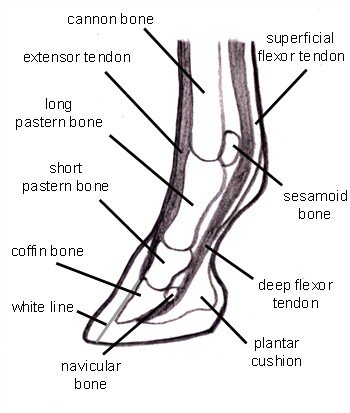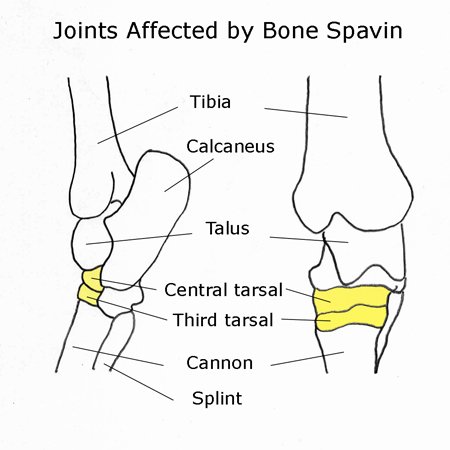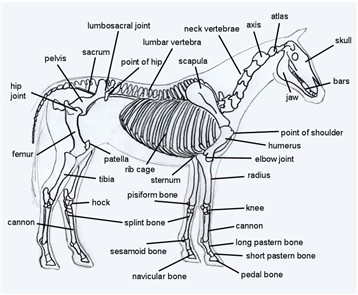Dealing with a Bowed Tendon
What It Is and How to Heal It

A bowed tendon is the horseman’s term for tendinitis, meaning strained, inflamed or torn tendon. The injury can be severe and chronic. A damaged tendon that is not properly treated and allowed the necessary time to heal can leave a horse unsound for life.
Tendon injuries can occur in any leg, but are most common in the front legs of horses. The superficial flexor tendon, just behind the cannon bone, is most often injured followed by the deep flexor tendon.
The severity of a bowed tendon and the length of healing time depend on how much damage has been done. When a tendon is strained fibers are broken and the tendon sheath is torn. Sometimes the blood vessels surrounding the area are ruptured as well.
The ruptured blood vessels are unable to supply the needed nutrients to make repairs to the damaged tissue. To make matters worse, blood and blood serum leak into the spaces between the tendons and the sheath to create scar tissue. The resulting scar tissue causes pain and lameness.
What Causes a Bowed Tendon?
- Forced exercise
- Heavy exercise without proper conditioning
- Fatigue
- Repeated missteps
- Fast work on poor surfaces (deep sand, mud, rough or hard surfaces)
- Improper shoeing
- Working a horse at too young an age
- Falls and accidents
- Poor conformation
- Kicking the tendon with a hind foot
- Toes too long add extra strain on tendons
Tendinitis is a common injury among jumpers, polo ponies and race horses.
Signs of a Bowed Tendon
The leg with the affected tendon will be hot, swollen and very painful. The horse will be very lame and will try to elevate their heel to relive pain and tension on the tendon. The swollen tendon will bulge out from the cannon bone as if it where a bow pulled back to release an arrow, hence the name.
A bowed tendon is called a ‘high bow’ if it occurs near the knee, and a ‘low bow’ if it occurs nearer the fetlock.
Treating a Bowed Tendon
Early discovery and immediate treatment are important when dealing with tendinitis. The first priority is to reduce the swelling and confine the animal’s movement. The immediate treatment is very labor-intensive.
Ice, cold packs, cold water and anti-inflammatories are all used to reduce swelling. Ideally ice should be applied day and night for the first 48 hours until the swelling is taken down. Overnight icing is often not possible, so the vet will wrap the legs with a soft cast or a tight bandage to keep the swelling down.
Most likely the vet will have the horse on some kind of pain killer. In the early stages it is very important that the horse not be allowed to walk on a ‘pain-deadened’ tendon injury.
It is best to wrap both legs. The healthy leg is wrapped to offer support for all the extra weight it is now bearing. Depending on the severity of the injury the horse may need leg wraps for up to three weeks. In the early stages of treatment the tendon should be immobilized. This means absolute rest and stall confinement if possible.
Massage has been known to help reduce swelling and prevent the formation of scar tissue.
Once the swelling is under control the vet will recommend a proper rehabilitation program. A mild tendon injury rehab will have the horse being hand-walked for 15 minutes twice a day for a month and gradually increased time waling according to the vet’s recommendations.
A moderate injury will have a much milder and slower progressing exercise routine. And a severely bowed tendon will need a very slow and restricted rehab program.
Time, Time and More Time
To completely heal, a bowed tendon will need at minimum six months rest, but a full year is more realistic. A horse that is not given a full recovery period is prone to re-injury and will not be a sound horse. Because proper healing time is so critical, ultrasound is used to monitor healing progress so as not to push the horse too fast or hard during rehabilitation.
Time and rest is the only proven healer of a strained tendon. Don’t be taken in by quick-fix products. If you suspect a tendon injury in your horse, call your vet immediately.
The faster a tendon injury is identified and treated the better the healing results. It is possible to bring a horse back to normal usage if the injury is not too severe and is allowed the proper healing time. Once healed, great care should be taken to introduce the horse to normal activity with regular but gradual exercise.
More Equine Anatomy Articles:
Bone Spavin

Learn to recognize Bone Spavin before you purchase a horse or how to manage it in a horse you already own.
This information is written for the horseman to better understand and cope with the variety of disease and injury that can occur during the course of horse ownership. Always consult with your Veterinarian regarding the care and treatment of your equine.
Home > Horse Diseases > Bowed Tendon

